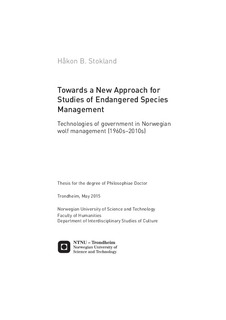Towards a New Approach for Studies of Endangered Species Management Technologies of government in Norwegian wolf management (1960s–2010s)
Doctoral thesis

Åpne
Permanent lenke
http://hdl.handle.net/11250/284481Utgivelsesdato
2015Metadata
Vis full innførselSamlinger
Sammendrag
The doctoral thesis develops a new approach for studies of endangered species management by
drawing on recent developments in science and technology studies, governmentality studies and
environmental history. By making technologies of government its main object of study, the approach
enables research not only of that which is commonly perceived as political, but also of techniques
and instruments that enable and effect politics in practice. It argues that the proliferation of
technologies of government over recent decades has transformed endangered species management
and protected organisms in profound ways, and that these developments constitute a blind spot in
the existing literature on endangered species management.
The thesis identifies and investigates such developments in Norwegian wolf management through
four articles. Article one investigates how genetic techniques were incorporated into Norwegian wolf
management in the 1990s, and argues that this process of ‘molecularisation’ was decisive in efforts
to construct and stabilize Scandinavian wolves as natural, vulnerable and worthy of protection.
Article two investigates how an extensive monitoring system, which enabled detailed and intensive
‘nationwide field studies in absentia,’ was constructed between the 1960s and the 2000s. Article
three investigates how the protection of wolves in Norway has been conducted in practice by asking
‘how many wolves it takes to protect the population.’ It examines the employment of ‘minimum
viable population size’ in regulations of wolf numbers, and argues that transitions in the authority to
define its content, first from biologists to nature managers, and later from nature managers to
politicians, involved major transitions in the number of wolves considered necessary for protecting a
viable population. By drawing on the empirical findings of the other three articles, article four
investigates whether the proliferation of technologies of government in Norwegian wolf
management has ‘preserved the wolves by transforming them.’ The article further explores whether
nature management, in general, has transformed so much that the recent period warrants the label
‘the age of biodiversity,’ and whether issues of naturalness, wildness and authenticity are new and
typical management challenges of the period. Avhandlingen utvikler en ny tilnærmingsmåte for forskning på forvaltning av truete arter gjennom å ta i bruk nyere utviklingstrekk innenfor fagområdene vitenskaps- og teknologistudier, governmentalitetsstudier og miljøhistorie. Ved å gjøre styringsteknologier til hovedobjekt for studiene fokuserer tilnærmingsmåten ikke bare på det som vanligvis oppfattes som politikk, men også på teknikker og instrumenter som muliggjør og setter politikk ut i livet i praksis. Avhandlingen argumenterer for at veksten i styringsteknologier de siste tiårene har endret forvaltningen av truete arter og beskyttede organismer på grunnleggende vis, og at denne utviklingen utgjør en blindflekk i den eksisterende forskningslitteraturen om forvaltning av truete arter.
Avhandlingen identifiserer og undersøker slike utviklingstrekk i norsk ulveforvaltning gjennom fire artikler. Den første artikkelen undersøker hvordan genetiske teknikker ble inkorporert i ulveforvaltningen på 1990-tallet, og argumenterer for at denne ‘molekyliseringen’ var avgjørende for prosessen hvor de skandinaviske ulvene ble konstruert og stabilisert som naturlige, sårbare og beskyttelsesverdige. Den andre artikkelen undersøker hvordan et omfattende overvåkingssystem, som muliggjorde detaljerte og intensive ‘landsomfattende feltstudier in absentia’, ble konstruert mellom 1960-tallet og 2000-tallet. Artikkel nummer tre undersøker hvordan beskyttelsen av ulv i Norge har blitt utført i praksis ved å spørre ‘hvor mange ulver som kreves for å beskytte bestanden’. Den undersøker bruken av ‘minste levedyktige bestandsstørrelse’ i reguleringen av antall ulv, og argumenterer for at overføringer i hvem som hadde autoritet til å definere innholdet, først fra biologer til naturforvaltere, og senere fra naturforvaltere til politikere, medførte avgjørende endringer i hvor mange ulver som ble ansett nødvendig for å beskytte en levedyktig bestand. Den fjerde artikkelen undersøker om veksten av styringsteknologier i norsk ulveforvaltning har ‘bevart ulvene ved å forandre dem’, og baserer seg på de empiriske funnene i de tre andre artiklene. Artikkelen utforsker videre om naturforvaltning generelt har gjennomgått så grunnleggende endringer i den senere perioden at det kan rettferdiggjøres å kalle den ‘biologisk mangfold-alderen’ (‘the age of biodiversity’), og om strid angående det naturlige, ville og ekte ved beskyttede arter er nye og typiske forvaltningsutfordringer i perioden.
Består av
Paper 1: Stokland, Håkon B.. Molecularising Nature: How Scandinavian Wolves became Natural. Forum 2013 (16) s. 1-9 This work is licensed under a Creative Commons Attribution 2.5 UK: Scotland License.Paper 2: Stokland, Håkon B.. Field Studies in Absentia: Counting and Monitoring from a Distance as Technologies of Government in Norwegian Wolf Management (1960s–2010s). Journal of the History of Biology 2014 ;Volum 48.(1) s. 1-36 The final publication is available at Springer via http://dx.doi.org/10.1007/s10739-014-9393-0
Paper 3: Stokland, Håkon B. How many wolves does it take to protect the population? Minimum viable population size as a technology of government in endangered species management (Norway, 1970s–2000s) Accepted for publication in Environment and History.
Paper 4: Stokland, Håkon B. The New Norwegian wolves – Preserving by transforming in the age of biodiversity?